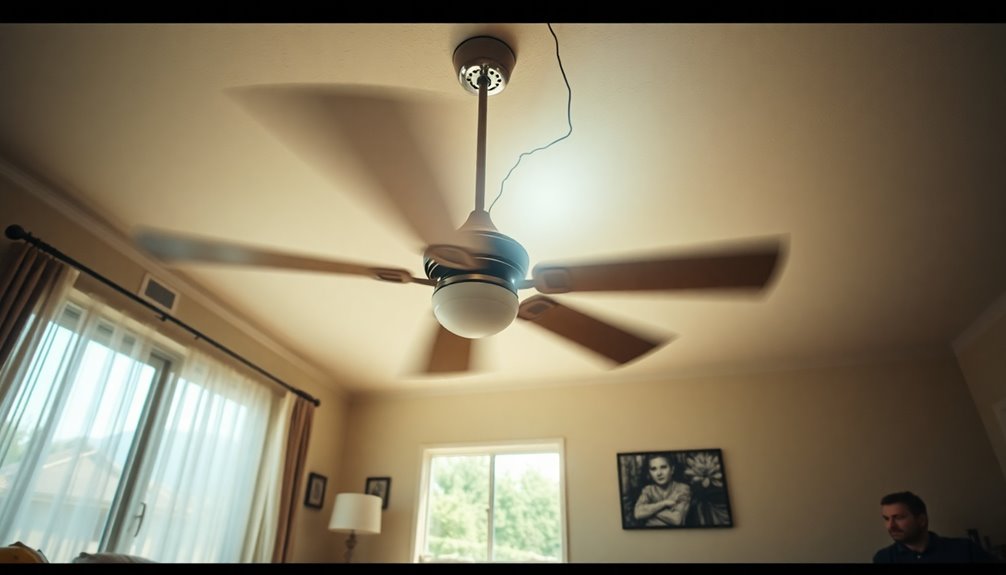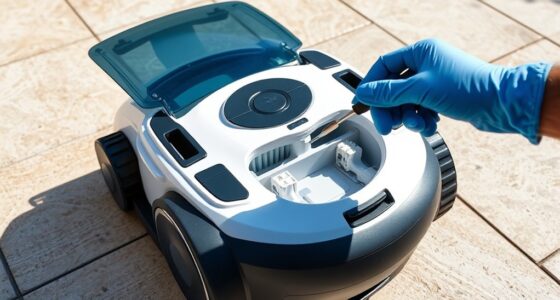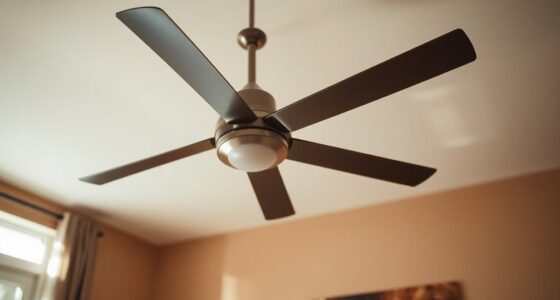Ceiling fans can fall due to several issues, like improper installation, loose screws, and inadequate support from the junction box. If you don't follow manufacturer guidelines or use a sturdy mounting system, your fan's stability is compromised. Regular inspections are significant—tighten any loose hardware and check for blade alignment to avoid wobbling. Be mindful of environmental factors, too, as strong winds can increase the risk. To enhance safety, consider fans with independent suspension cables. By staying proactive about installation and maintenance, you can greatly reduce the chances of disaster. There's more valuable information to help keep your home safe.
Key Takeaways
- Ensure proper installation by using a dedicated junction box and following manufacturer guidelines to prevent inadequate support.
- Regularly inspect and tighten all screws and bolts to avoid loose hardware that can lead to falls.
- Maintain adequate support structures by using a fan brace box and ensuring the ceiling can handle the fan's weight.
- Correctly align blades and check for warping to prevent wobbling that can destabilize the fan during operation.
- Implement safety measures, such as safety blade locks and cables, to enhance stability and prevent potential disasters.
Causes of Ceiling Fan Falls
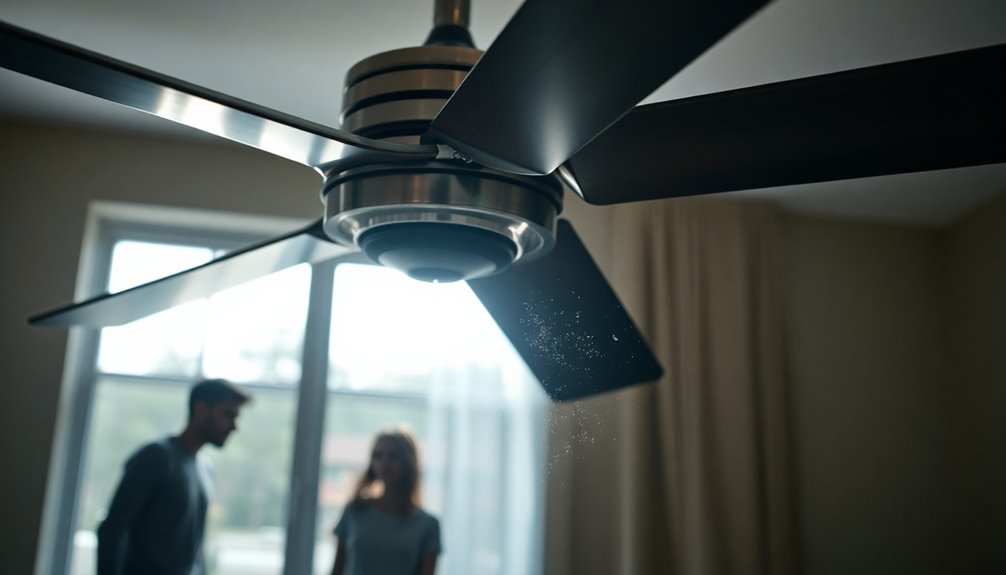
When it comes to ceiling fan falls, several key factors can put you and your space at risk. Improper installation is one major culprit, as not following manufacturer guidelines can lead to inadequate support, causing ceiling fan falls.
Loose or faulty hardware, like screws and bolts, can also pose a threat if you don't regularly inspect and tighten them. Additionally, an inadequate support structure, such as using non-rated junction boxes, increases the chances of detachment.
Vibration issues from imbalanced blades or damaged motors may destabilize the fan, leading to falls during operation. Finally, environmental factors like strong winds or seismic activity can contribute to fan movement and detachment if your installation isn't secure enough.
Stay vigilant to prevent these risks!
Importance of Proper Installation
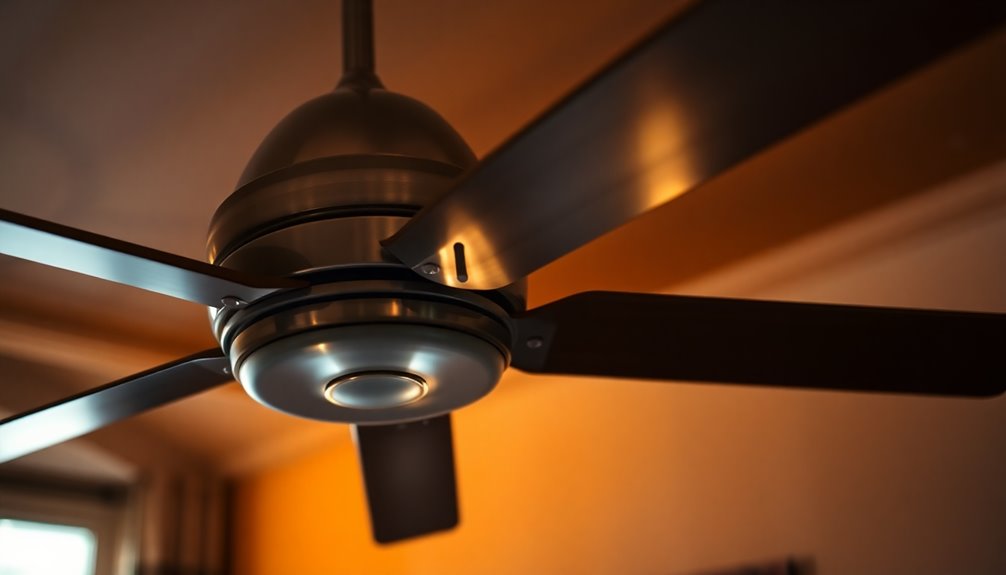
Proper installation of ceiling fans is essential not only for peak performance but also for your safety. Without proper installation, the risk of your fan detaching increases considerably.
| Installation Aspect | Importance | Recommendation |
|---|---|---|
| Junction Box | Supports weight and movement | Use a dedicated electrical junction box |
| Height | Guarantees safety and peak airflow | Mount at least 7 feet; ideally 8-9 feet |
| Manufacturer Guidelines | Prevents improper mounting | Follow all provided instructions |
| Fan Brace Box | Provides secure support | Always use a fan brace box |
| Regular Inspections | Identifies potential issues | Check mounting hardware regularly |
Additionally, ensuring that your ceiling fan is installed correctly can help maintain indoor air quality, which is essential for a healthy living environment.
Checking for Support Structures
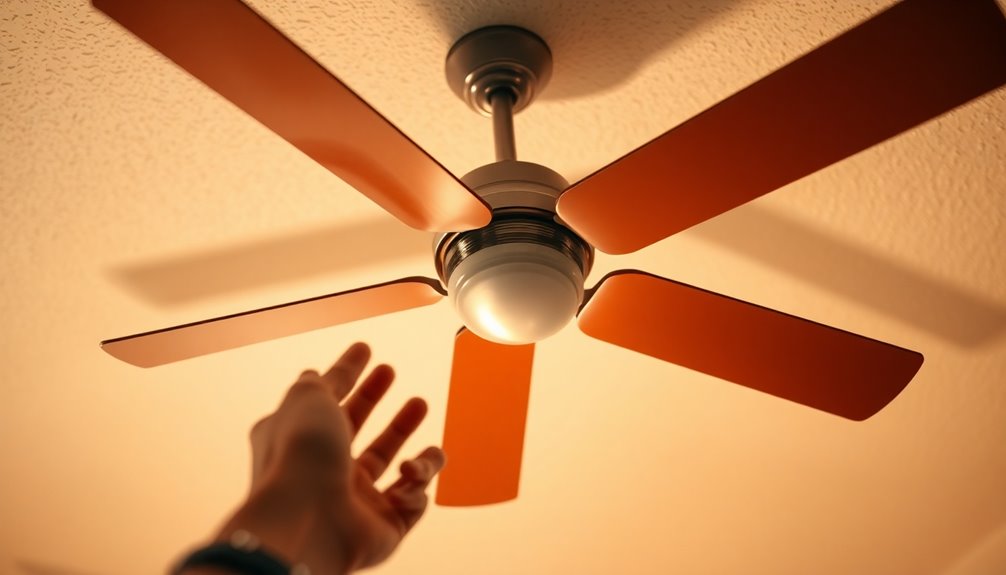
After verifying your ceiling fan is properly installed, checking for adequate support structures is the next step in maintaining safety.
Ceiling fans need a dedicated electrical junction box designed to support their weight and movement; using an ordinary lighting fixture box can lead to dangerous situations. Make certain the ceiling support structure can handle the fan's weight, and consider installing a fan brace box for extra security against detachment.
It's also important to maintain at least 18 inches of clearance from walls or doors to prevent collisions and guarantee proper airflow.
Regularly inspect the mounting hardware and support structures to confirm that all screws and bolts are secure, following the manufacturer's guidelines for installation and weight capacity.
Ensuring Quality Assembly
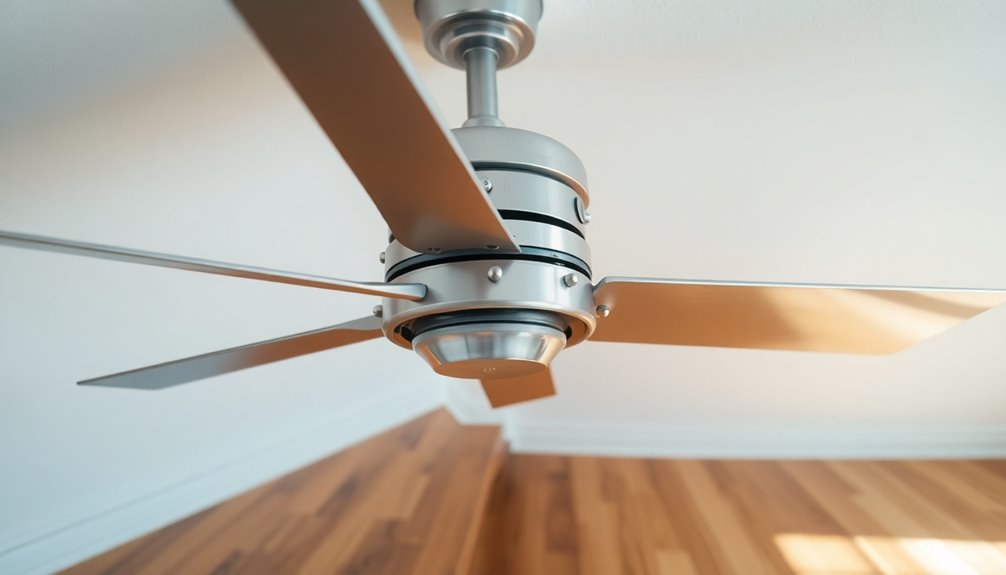
When installing your ceiling fan, make certain the blades are aligned properly to prevent wobbling and potential hazards.
Securely attach each blade using the right techniques to guarantee they stay in place and function efficiently.
Regularly check for loose screws and follow the manufacturer's guidelines to maintain quality assembly and safety.
Blade Alignment Importance
Ensuring the correct alignment of ceiling fan blades is essential for maintaining stability and preventing hazardous wobbling. Misaligned blades can lead to instability, increasing the risk of the fan detaching from its mount.
To achieve proper blade alignment, make sure all blades are securely attached and tightened with screws before installation. Warped or bent blades can cause uneven rotation, leading to vibrations that may loosen light fixture covers.
It's a good idea to conduct regular inspections of blade alignment to catch any issues early, as misalignment can worsen over time. Using a level tool during installation can also help verify blade balance, ensuring peak performance and reinforcing the importance of safety precautions in your ceiling fan setup.
Secure Attachment Techniques
Proper assembly of your ceiling fan is essential for both performance and safety. To guarantee secure attachment techniques, always use a dedicated electrical junction box designed specifically for ceiling fans. This provides the necessary support to prevent any risk of detachment.
Additionally, install a fan brace box instead of relying on existing lighting fixture boxes, which may not handle the weight and movement of ceiling fans effectively. Before installation, check for misaligned blades, as misalignment can cause wobbling and increase the risk of loose light fixture covers.
Finally, make it a habit to inspect all mounting hardware and tighten screws and bolts every six months. This regular maintenance keeps your ceiling fan securely attached and reduces the chance of accidents.
Expert Installation Recommendations
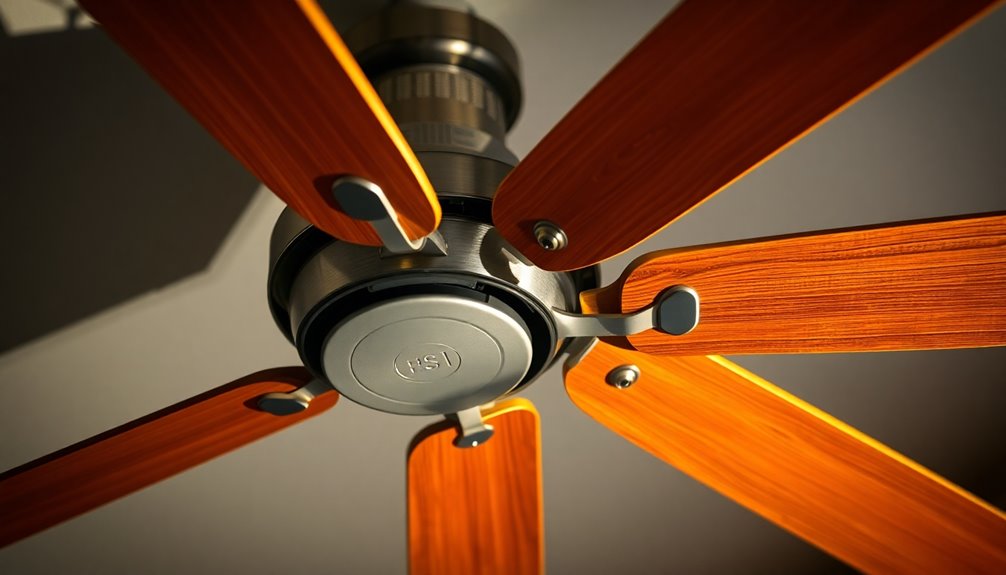
When installing a ceiling fan, it's essential to verify proper support to prevent falls.
You might want to contemplate hiring a professional electrician who can assure that everything meets safety standards and local codes. Additionally, ensuring the fan is installed in accordance with local family court regulations can help mitigate risks.
Taking these steps won't only enhance your fan's performance but also give you peace of mind.
Proper Support Structure
To install a ceiling fan safely, it's vital to use a dedicated electrical junction box designed specifically for its weight. This support structure guarantees the fan is securely mounted and reduces the risk of detachment.
Avoid using existing lighting fixture boxes unless they've been upgraded to meet the necessary weight and safety standards. A fan brace box is critical for a stable installation, providing the extra support needed for safe operation.
Additionally, maintain at least 18 inches of clearance from walls and doors to enhance stability and minimize collision risks.
For peace of mind, consult with expert electricians to confirm compliance with local building codes and further reduce the likelihood of structural failures.
Professional Installation Benefits
Engaging a professional for ceiling fan installation offers significant advantages that enhance safety and functionality.
Professional electricians use dedicated electrical junction boxes to securely support the fan's weight, minimizing the risk of detachment and falls. They adhere to local building codes, ensuring your fan is compliant with safety standards.
With the right tools and expertise, they align fan blades properly, reducing wobbling and the dangers of loose components. Additionally, experts can identify and resolve underlying issues with your ceiling's support structure before installation, promoting long-term safety and stability.
Regular Maintenance Practices
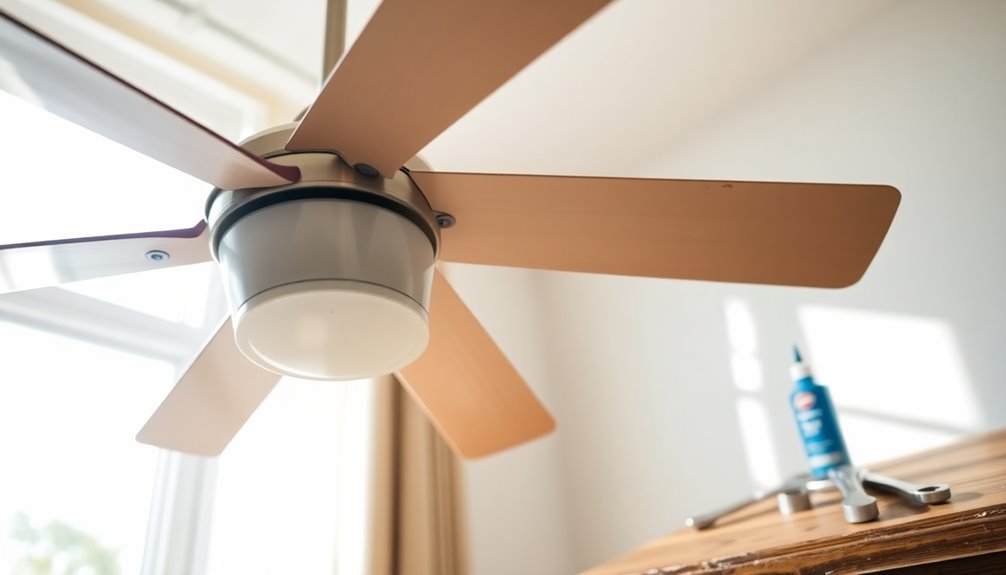
Regular maintenance practices for your ceiling fans are essential in preventing accidents and guaranteeing a safe environment.
To keep your fans functioning properly, follow these key steps:
- Inspect the fan every six months, tightening screws and bolts to avoid loose components.
- Clean the fan blades monthly to remove dust and debris, preventing imbalances.
- Lubricate the bearings annually to guarantee smooth operation and reduce strain on the motor.
- Check electrical connections for wear or damage, guaranteeing all wiring is secure.
Safety Measures to Implement
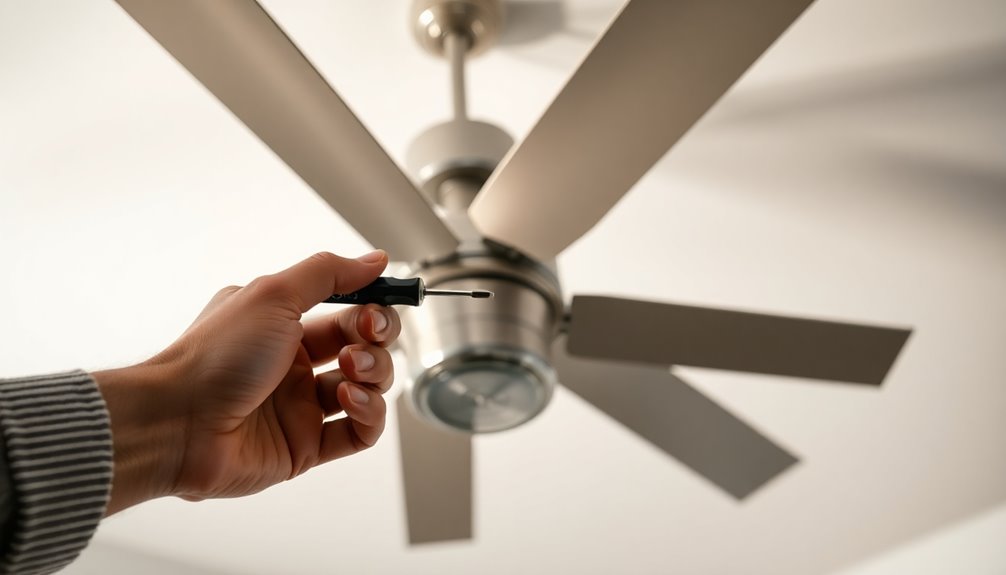
Maintaining your ceiling fans is just the beginning when it comes to guaranteeing safety in your home.
Make sure your fans are installed using a dedicated electrical junction box designed for ceiling fans to provide proper support and prevent detachment. Regularly inspect and tighten all screws and bolts, as loose hardware can lead to falls.
To enhance safety, utilize safety cables and blade locks, preventing blades from detaching during operation. Always follow the manufacturer's installation guidelines to guarantee proper mounting and avoid accidents.
Conduct routine maintenance checks to verify blade alignment and look for any signs of wear or damage.
Understanding Fan Wobble
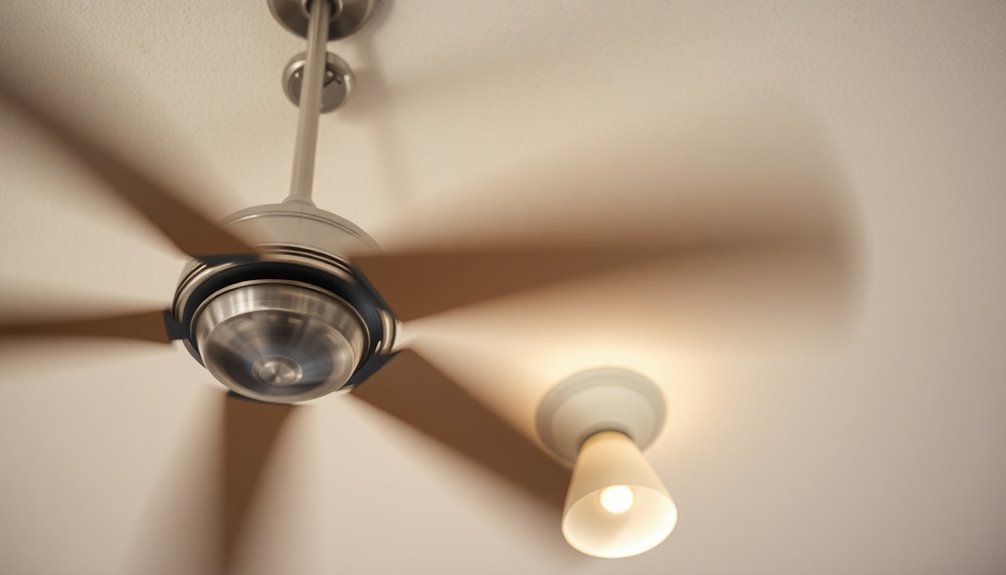
Fan wobble can be frustrating and might even pose safety risks.
You'll often find that it's caused by misaligned or bent blades, which can lead to vibrations and instability.
Fortunately, with proper maintenance and attention to blade alignment, you can easily solve these wobbling issues and keep your ceiling fan running smoothly.
Causes of Fan Wobble
While enjoying the cool breeze from your ceiling fan, you might notice it wobbling unexpectedly.
This fan wobble can stem from several common issues related to fan blades. Here are the main causes:
- Misaligned blades: Warped or bent blades disrupt balance during operation.
- Loose screws: Improperly attached blades can lead to instability.
- Lack of maintenance: Neglecting to tighten screws and check blade alignment increases the chance of wobble.
- Environmental factors: Air currents or vibrations from nearby appliances can exacerbate the issue.
Solutions for Wobbling Fans
To effectively reduce wobbling in your ceiling fan, start by addressing potential misalignments and loose components. A wobbly fan often indicates that the blades are misaligned, so adjusting them can restore balance.
Regularly check and tighten all screws and bolts to guarantee everything is secure. Inspect the blades for any warping or bending—these imperfections can cause instability and should be replaced if needed.
Additionally, use a level tool to verify that your fan is mounted evenly; an uneven installation leads to wobbling during operation.
Finally, make sure that your fan blades have at least 18 inches of clearance from walls and other objects to minimize collision risks and enhance stability. To ensure long-term reliability, consider implementing a regular maintenance schedule for your ceiling fan, which can help identify issues before they lead to more significant problems.
Selecting Safe Ceiling Fans

How can you guarantee your ceiling fan is both stylish and safe? Selecting the right ceiling fan isn't just about aesthetics; it's essential for safety too. Here are four key factors to take into account:
- Reputable Brands: Choose brands known for quality and compliance with local building codes.
- Modern Installation: Look for fans with flange suspension mechanisms for added support.
- Safety Features: Opt for fans that include independent suspension backup cables and safety blade locks.
- Smooth Operation: Make sure the fan has a smooth motor to minimize vibrations and reduce the risk of components loosening. Additionally, regular maintenance can help prevent dangerous situations associated with clicking ceiling fans.
Benefits of Ceiling Fans
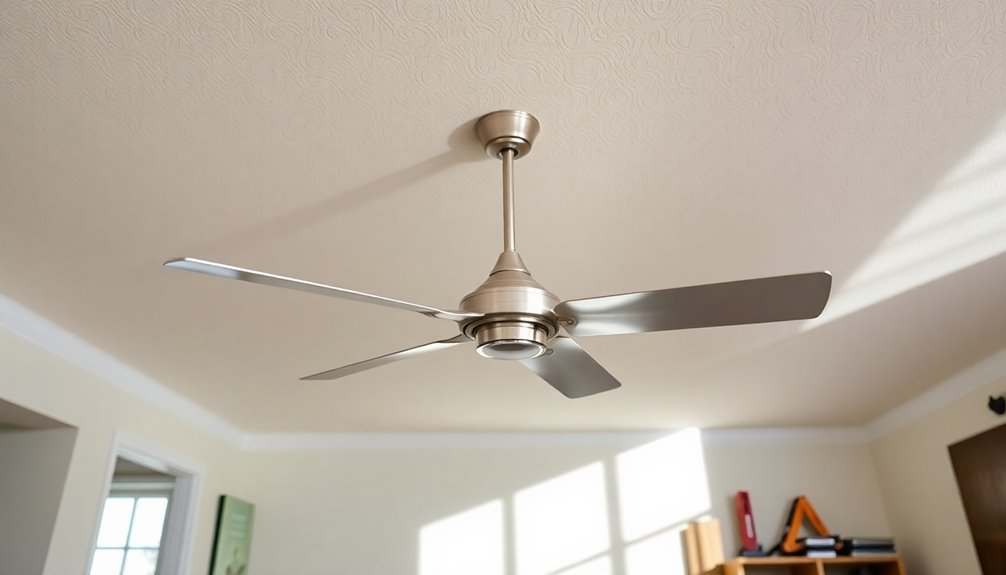
Ceiling fans offer numerous benefits that go beyond simple cooling. They're energy-efficient, cutting cooling costs by up to 30% compared to air conditioning units. You'll notice improved air circulation, eliminating hot spots and creating comfort during warmer months. Plus, with their reverse function, ceiling fans help circulate warm air in winter, maintaining a consistent indoor temperature year-round. Additionally, when used in conjunction with energy-efficient systems, ceiling fans can further enhance overall energy savings.
Here's a quick look at the benefits of ceiling fans:
| Benefit | Description |
|---|---|
| Energy Efficiency | Uses up to 30% less electricity than AC |
| Improved Air Circulation | Eliminates hot spots for comfort |
| Year-Round Use | Circulates warm air in winter |
| Aesthetic Variety | Complements various home decor styles |
| Cost-Effective Alternative | Economical solution to central air conditioning |
Frequently Asked Questions
Is It Common for Ceiling Fans to Fall?
It's not common for ceiling fans to fall when they're installed properly.
Most issues arise from improper installation or inadequate support. You should always verify that the mounting hardware is secure and regularly check for loose screws.
Environmental factors like strong winds can also play a role, but with the right precautions and maintenance, you can greatly reduce the risk of your ceiling fan coming down unexpectedly.
Stay proactive about safety!
Why Do Designers Hate Ceiling Fans?
Designers often dislike ceiling fans because they can disrupt the aesthetic of a room.
Their bulky appearance clashes with modern, clean lines, and they may feel outdated compared to sleek air conditioning solutions.
You might also notice that poorly installed fans can wobble or create safety hazards, adding to the frustration.
Additionally, the array of styles can confuse you, making it tough for designers to recommend the right fan that fits their vision.
How to Prevent a Ceiling Fan From Falling?
Did you know that improperly installed ceiling fans can cause over 10,000 injuries annually?
To prevent your ceiling fan from falling, guarantee it's mounted on a dedicated junction box. Regularly check and tighten all screws and bolts, maintain a height of 8 to 9 feet, and keep at least 18 inches from walls.
Using advanced suspension mechanisms and conducting routine maintenance can also enhance stability and safety, making your fan reliable.
How to Make Sure a Ceiling Fan Is Secure?
To make sure your ceiling fan is secure, start by using a dedicated electrical junction box designed for ceiling fans.
Position the fan blades at least 7 feet above the floor for safety.
Regularly check that the blades are tightly attached and properly aligned to prevent wobbling.
Inspect the mounting hardware every six months, tightening any loose screws or bolts.
Consider adding safety cables for extra support during installation, enhancing overall stability.
Conclusion
In conclusion, keeping your ceiling fan securely in place is essential for safety. Remember, "an ounce of prevention is worth a pound of cure." By ensuring proper installation, checking support structures, and choosing high-quality fans, you can avoid potential disasters. Don't hesitate to consult professionals if you're unsure. With the right precautions, you can enjoy the cooling benefits of your ceiling fan without worrying about it falling. Stay safe and keep your home comfortable!
